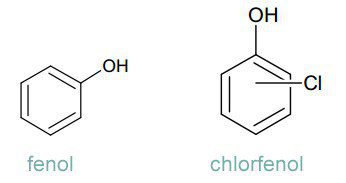Phenols and their removal from water
Phenols occurring in the water are either of natural origin or industrial. Naturaly originated phenols appear during biosynthetic processes or decomposing of the animal/plant bodies. Industrially originated phenols appear during the produce of plastics, disinfection products, pharmacy drugs, pesticides, paper, in steel or petrochemical industry.
What are phenols?
Phenols belong to a group of volatile organic substances. The most basic phenol is phenol itself. Then for example chlorophenol.

Chlorophenols have an acrid and strong odor and they don’t burn. With higher temperatures they part to CO, CO2 and HCl, which are substances that strongly irritate mucous membranes.
Chlorophenols are imunotoxic, phytotoxic and embryotoxic substances with no mutagene or carcinogene effects proved.
Chlorophenols are used for example for wood protection as antiseptic products.
Phenol properties
Achromatic liquids or crystalic substances with their own characteristic odor. Beside high-molecular ones, they are well soluble in water. On the contrary the low-molecular ones are not stable in water. Mostly they are harmful to the health, even carcinogene. They are able to form oxion salts, esthers and phenolates.
Phenols in the water
Phenols occur in water mostly thanks to the industrial pollution. Into the natural water sources they come often from factories which process brown coal or black coal tar. Then they come also from pharmacy, petrol and plastic or steel industry.
Phenol effects on health
Phenols affect our health negatively. Phenol and its compounds can damage, even destroy some human cells and therefore cause serious health complications.
Possible outcomes
Headache, skin irritation, breathing tract irritation, nausea, passing out, intestinal problems, stomach problems, poisoning.
Phenol can get into the body by contaminated water ingestion, by breathing or smoking.
Removal of phenols from water
Thanks to its high efficiency the mostly used method is an adsorption, then for example oxidation processes.
Removal of phenols by adsorption
During this process the substances from a solution are eliminated thanks to their bonding with a surface of the so called adsorbent. This is the solid matter. The bonded substance is called the adsorbate.
Active coal/carbon as the most effective solution
(AC, Active carbon)
Active coal is the most efficient adsorbent for phenol removal from water.
- Active coal
Other options are use of synthetic resins, loamy minerals and red mud.
As for other methods of phenolytic compounds removal, a method of ozonization, wet oxidation and oxidation through hydrogene peroxide is used.